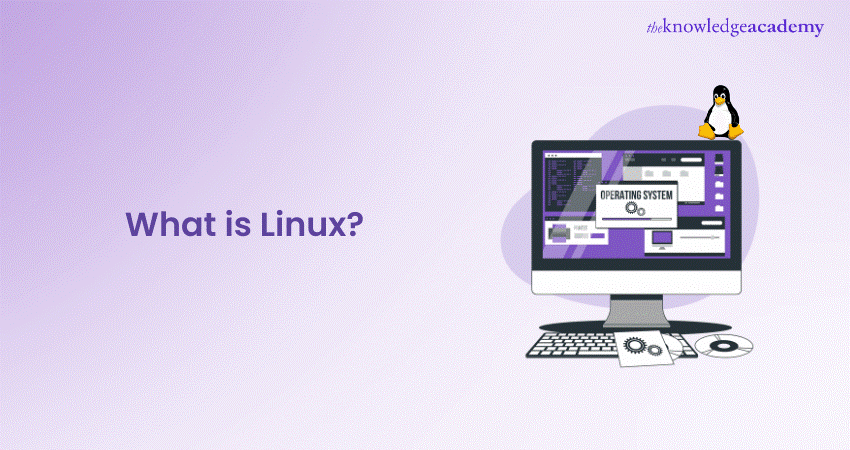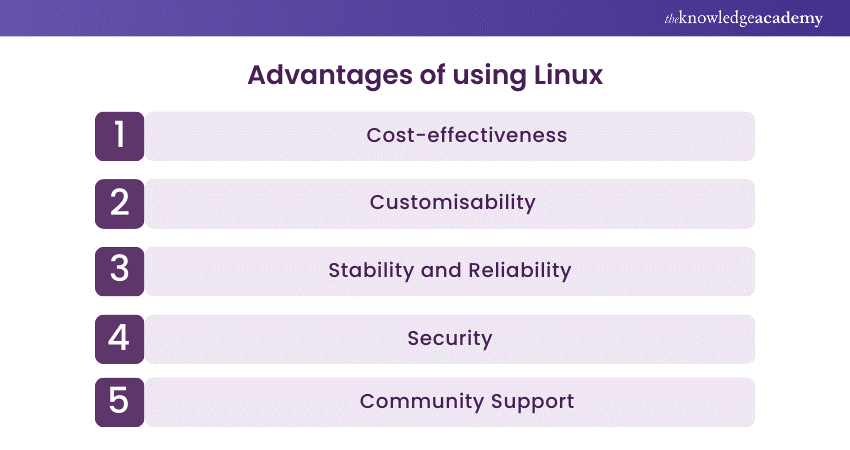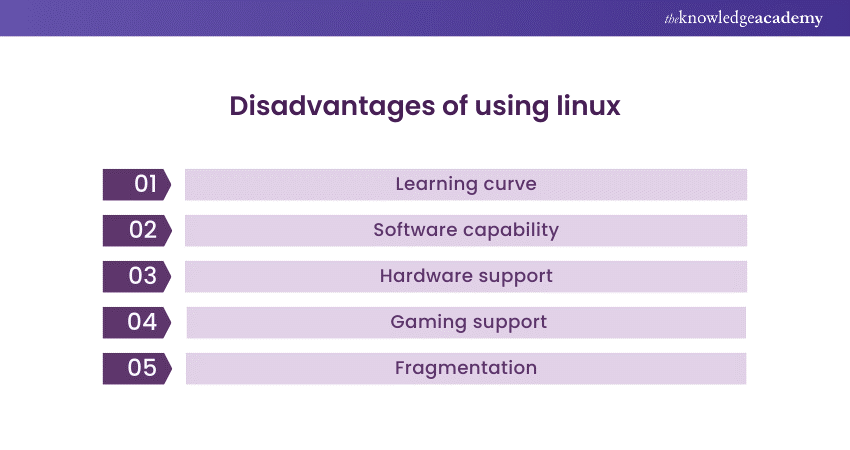We may not have the course you’re looking for. If you enquire or give us a call on +852 2592 5349 and speak to our training experts, we may still be able to help with your training requirements.
We ensure quality, budget-alignment, and timely delivery by our expert instructors.

An Operating System (OS) is the lifeblood of a computer, orchestrating the harmonious interplay of hardware and software. The evolution of OS has proven integral to the development of the modern digital business environment. Of the many Operating Sytems (OS) dominating the computing landscape, Linux stands as one of the most prominent.
Linux’s influence goes beyond technical achievements as it challenges the traditional business models of software development, emphasising collaboration over competition. But exactly What is Linux? This blog explores the same focusing on its origins, key features, advantages and disadvantages. Read on and expand your understanding of What is Linux
Table of Contents
1) Understanding What is Linux
2) How Does Linux Differ From Other Operating Systems (OS) ?
3) What are the Key Features of Linux?
4) Linux Components and Terminology
5) Pros and Cons of Using Linux
6) Installing Linux
7) Installing Software on Linux
8) How is Linux different from Windows and macOS?
9) Can beginners use Linux, or is it only for experts?
10) Conclusion
What is Linux?
Linux is an open-source Operating System (OS) that functions as the fundamental software on a computer for managing hardware resources and providing services for applications. It's renowned for its stability, security, and flexibility and is used in a wide range of devices, from servers and embedded systems to desktop computers. It is the base for various Linux distributions like Ubuntu, Fedora, and Debian.
How Does Linux Differ From Other Operating Systems (OS)?
Linux is similar to other OS such as Windows, macOS or iOS in many ways, including features such as a graphical interface, word processors, photo editors, etc. But there are significant ways in which Linux Operating System (OS) differs from the others:
a) Linux is an open-source software, allowing public access to its code for viewing, editing, and contributions for users with the right skills.
b) While the core components of the Linux operating system (OS) remain common, there are numerous Linux distributions, each offering different software options.
c) Linux is highly customisable, allowing users to swap out applications like word processors and web browsers.
d) Users can also choose core components, such as the system for displaying graphics and other user-interface elements
What are the Key Features of Linux?
Linuxboasts a range of key features that make it a preferred choice for individuals and organisations alike:
1) Open-source Nature: Linux's source code is freely available.
2) Stability & Reliability: Linux ensures minimal crashes.
3) Security: Strong security features and regular updates.
4) Flexibility & Customisation: Users can tailor Linux to their needs.
5) Scalability: Linux adapts across devices, from embedded systems to supercomputers.
6) Multitasking & Multi-user Support: Allows concurrent processes, security and privacy.
7) Extensive Software Ecosystem: A range of open-source applications.
8) Hardware Compatibility: Supports diverse hardware, including legacy and modern systems.
Become a proficient Linux System Administrator with our comprehensive Administering Linux Systems Course today!
Linux Components and Terminology
Here are some of the most important components and terms associated with Linux:
1) Bootloader
The bootloader is a crucial component in the Linux boot process. It resides in the system's Master Boot Record (MBR) or EFI system partition, initiating the loading of the Operating System into RAM. Popular bootloaders include GRUB and LILO. They allow users to choose the desired Operating System if multiple OS installations exist on the same device.
2) Kernel
The kernel is the heart of the Linux Operating System. It manages system resources, such as CPU, memory, and peripherals, as an intermediary between hardware and software. The monolithic Linux kernel, including core functionalities and device drivers, provides a stable foundation for other software.
3) Init system
The init system is responsible for initialising the user space and managing system processes. Traditionally, systems used System V init, but modern Linux distributions often adopt alternatives like Systemd. The init system coordinates the startup and shutdown sequences, ensuring a smooth transition from boot to user login.
4) Daemons
Daemons are background processes in Linux that run independently of user interaction. They perform various tasks, such as handling network requests, managing system logs, or providing printing services. Examples include the Apache web server daemon (https) and the SSH daemon (sshd).
5) Graphical server
The graphical or X server manages graphic elements on Linux systems. It provides a framework for graphical user interfaces (GUIs) and allows applications to display windows, icons, and other visual elements. X.Org Server is a widely used graphical server in Linux environments.
6) Desktop environment
The desktop environment is a user interface that enhances the overall user experience in Linux. It includes the desktop, icons, file managers, and applications. In the context of managing system configurations, the RPM Command in Linux is also essential, as it helps install, update, and remove software packages within these desktop environments. Common desktop environments include GNOME, KDE, and Xfce, which create a cohesive and user-friendly interface, making it easier for users to interact with the system and its applications.
Achieve cost-effective solutions for businesses with our Linux Certification! Register today!
Pros and Cons of Using Linux
This section of the blog will shed light on the advantages and disadvantages that come equipped with the Linux OS:
What are the Advantages of Using Linux?
Linux offers a plethora of advantages that make it a compelling choice for individuals, businesses, and organisations. From its cost-effectiveness to its customisability, stability, security, and community support, Linux stands out as a versatile and powerful Operating System that meets a wide range of computing needs. Let's explore these advantages in more detail:

1) Cost-effectiveness: One of the key advantages of Linux is its cost-effectiveness. Linux is open-source, which means it is available for free, eliminating the need for expensive software licenses. This makes Linux an attractive option for individuals, small businesses, and enterprises looking to reduce IT costs. Moreover, Linux runs efficiently on older hardware, extending the lifespan of existing machines and reducing the need for frequent hardware upgrades.
2) Customisability: Linux offers unparalleled customisability, allowing users to fit the Operating System to their specific requirements. With Linux, users have the freedom to choose from a wide range of desktop environments, such as GNOME, KDE, or XFCE, and customise the look and feel of their system. Additionally, users can select the software packages and applications that best suit their needs, creating a personalised computing environment that enhances productivity and workflow, including the ability to Rename Files in Linux for better file management.
3) Stability and Reliability: Linux is renowned for its stability and reliability. The robust architecture and design principles of Linux ensure that it can handle demanding tasks and run for extended periods without crashes or performance degradation. Linux-based systems are known for their uptime and can provide uninterrupted service, making them ideal for critical applications, servers, and enterprise environments. The stability and reliability of Linux contribute to enhanced productivity and reduced maintenance costs.
4) Security: Linux's security is a significant advantage that appeals to both individuals and organisations. The open-source nature of Linux allows for continuous security audits and prompt resolution of vulnerabilities. The Linux community quickly addresses security issues, ensuring that patches and updates are released promptly. Linux also provides granular user permissions and access controls, reducing the risk of unauthorised access and data breaches. The robust security features of Linux make it a trusted choice for users who prioritise the protection of their digital assets.
5) Community Support: Linux benefits from a vibrant and supportive community. The Linux community is made up of developers, enthusiasts, and users who actively contribute to its development and provide support to fellow users. Online forums, mailing lists, and dedicated websites are available where users can seek assistance, share knowledge, and engage in discussions. The Linux community fosters a collaborative environment, ensuring that users are not alone in their Linux journey and have access to a wealth of expertise and resources.
What are the disadvantages of Using Linux?
While Linux brings numerous advantages to the table, it is essential to consider some of its potential disadvantages. Although these aspects don't undermine the overall strength of Linux, they may pose challenges to specific users. Let's explore some of the notable disadvantages of Linux:

1) Learning curve: One of the primary challenges for newcomers is the learning curve that is associated with Linux. Compared to more mainstream Operating Systems, Linux can require a steeper initial learning curve, especially for users accustomed to Windows or macOS. Linux often relies on command-line interfaces and configuration files, which may appear unfamiliar to those accustomed to graphical user interfaces (GUIs). However, with resources like documentation, online communities, and user-friendly distributions, such as Ubuntu, the learning curve can be mitigated, and users can gradually become proficient in navigating Linux environments.
2) Software capability: While Linux boasts a rich software ecosystem, it may not offer the same breadth of software availability as proprietary Operating Systems. Some popular commercial software, especially niche or industry-specific applications, may have limited or no official Linux support. Although open-source alternatives often exist, they may only sometimes match the exact feature set or user experience of their proprietary counterparts. However, the growing popularity of Linux has prompted increased software compatibility, and many mainstream applications now have Linux versions or compatible alternatives.
3) Hardware support: Although Linux has made significant strides in hardware compatibility, it may still face challenges with certain hardware components. Hardware manufacturers sometimes prioritise developing drivers and firmware for Windows or macOS, leading to delayed or limited support for Linux. While many hardware devices work seamlessly with Linux out of the box, some less common or specialised hardware, such as certain printers or wireless adapters, may require additional configuration or have limited driver availability. However, the Linux community and developers are actively working to improve hardware support and address these compatibility gaps.
4) Gaming support: Historically, Linux has faced limitations in gaming support compared to other Operating Systems, particularly when considering Linux vs Windows. The majority of mainstream game titles are developed and optimised for Windows, making them incompatible with Linux without workarounds or emulation.
However the situation has improved with the emergence of dedicated gaming platforms like Steam for Linux and the growing popularity of Linux-compatible game titles. The overall gaming library still needs to be more extensive compared to other platforms.
5) Fragmentation: Linux's open-source nature has led to a diverse range of distributions, each with its own characteristics, package management systems, and user interfaces. This fragmentation can overwhelm users, particularly those new to Linux, as they must navigate the different options and decide which distribution suits their needs. Software compatibility and community support can also vary across distributions, potentially leading to inconsistencies or difficulties in finding specific solutions. However, the variety of distributions also allows users to find one that aligns closely with their preferences, ensuring a tailored computing experience.
Are you looking to expand your proficiency as a Linux Server Administrator? Sign up for our Linux Shell Programming Course now!
Installing Linux
Installing an Operating System can be daunting for many, but surprisingly, the Linux Operating System offers one of the most effortless installation guidance. Most Linux versions provide a Live distribution, enabling users to run the OS from a CD/DVD or USB flash drive without altering the hard drive.
This trial run allows users to explore full functionality without committing to installation. When ready to install, a simple double-click on the "Install" icon initiates the process. Using Ubuntu Linux as an example, the installation wizard guides users through essential steps.
The process typically involves:
a) Ensuring system compatibility.
b) Optional installation of third-party software.
c) Wireless setup if needed.
d) Specifying hard drive allocation.
Users decide on installation preferences, such as dual booting, utilising the entire hard drive, upgrading an existing Linux installation, or overwriting a previous version. Location and keyboard layout choices follow, leading to the user setup for creating a username and password. After completion, a reboot finalises the installation, providing users with a seamlessly configured Linux Operating System. Using commands like the Cat Command in Linux to view files further simplifies interactions, making Linux installations accessible even for those unfamiliar with the intricacies of Operating System setups. This ease of installation and configuration is often contrasted with other operating systems, such as in an AIX vs Linux comparison, where AIX installations can be more complex, especially on non-IBM hardware.
Installing Software on Linux
Much like the straightforward installation of the Linux Operating System, installing applications is also user-friendly. Contemporary Linux distributions often feature an app store, a centralised hub where users can search for and install software. Examples of such software include:
a) GNOME Software for Ubuntu
b) AppCenter for Elementary OS
c) Deepin Software Center for Deepin
d) AppStore for openSUSE
Despite different names, these tools serve the same purpose—providing a central location for software management.
a) App stores provide a centralised hub for software management.
b) Software can be installed via GUI or command-line interface.
c) Debian-based distributions use the apt-get tool, with a simple command like "sudo apt-get install wget."
d) Fedora-based distributions use the yum tool with a command like "yum install wget."
These examples highlight the user-friendly nature of software installation on Linux, dispelling any misconception about it being challenging.
How is Linux Different From Windows and macOS?
Unlike Windows and macOS, Linux is open-source, allowing users to modify and distribute its code freely. It is also more customizable, secure, and widely used in server environments.
Can Beginners Use Linux, or is it Only for Experts?
Linux is available in user-friendly distributions like Ubuntu and Linux Mint, making it accessible for beginners while still offering powerful features for advanced users and developers.
Conclusion
In conclusion, understanding What is Linux opens the door to a versatile Operating System widely used in diverse domains. By incorporating Oracle Linux, you can take advantage of Oracle's unique capabilities combined with the open-source flexibility and robustness of Linux, making it an ideal choice for system administrators, developers, and tech enthusiasts. We hope this blog helps you not only understand What is Linux but also harness its innovative tremendous potential.
Unlock your potential in the world of Linux through our Linux Fundamental Course today!
Frequently Asked Questions
How is Linux Different From Windows?

Linux and Windows differ fundamentally in their architecture and user philosophy. Linux, built on a Unix foundation, is open-source, providing extensive customisation and stability. Users can modify the source code to meet specific needs. Windows, a proprietary system, emphasises user-friendly interfaces but limits customisation.
Can I Run Linux Alongside Windows on my Computer?

Yes, you can run Linux alongside Windows on your computer by setting up a dual-boot system. This allows you to choose between Operating Systems during startup. During the installation of Linux, you can allocate a portion of your hard drive for Linux while keeping Windows intact. This way, you can enjoy the benefits of both Operating Systems on the same machine.
What are the Other Resources Provided by The Knowledge Academy?

The Knowledge Academy takes global learning to new heights, offering over 3,000 online courses across 490+ locations in 190+ countries. This expansive reach ensures accessibility and convenience for learners worldwide.
Alongside our diverse Online Course Catalogue, encompassing 19 major categories, we go the extra mile by providing a plethora of free educational Online Resources like News updates, Blogs, videos, webinars, and interview questions. Tailoring learning experiences further, professionals can maximise value with customisable Course Bundles of TKA.
What is The Knowledge Pass, and How Does it Work?

The Knowledge Academy’s Knowledge Pass, a prepaid voucher, adds another layer of flexibility, allowing course bookings over a 12-month period. Join us on a journey where education knows no bounds.
What are the Related Courses and Blogs Provided by The Knowledge Academy?

The Knowledge Academy offers various Linux Certification courses, including Linux Fundamentals, Linux Shell Programming and Administering Linux Systems Course. These courses cater to different skill levels, providing comprehensive insights into Unix vs Linux.
Our IT Infrastructure and Networking blogs cover a range of topics related to Linux, offering valuable resources, best practices, and industry insights. Whether you are a beginner or looking to advance your Linux skills, The Knowledge Academy's diverse courses and informative blogs have you covered.
Upcoming IT Infrastructure & Networking Resources Batches & Dates
Date
 LINUX Fundamentals Course
LINUX Fundamentals Course
Thu 6th Mar 2025
Thu 22nd May 2025
Thu 24th Jul 2025
Thu 25th Sep 2025
Thu 11th Dec 2025






 Top Rated Course
Top Rated Course



 If you wish to make any changes to your course, please
If you wish to make any changes to your course, please


